Trends in website design are ever-evolving. It’s a fast-paced industry, but any business with a digital marketing presence should take efforts to stay informed and keep up with best practices. Just as you would ensure employees are helpful and informative to customers in a physical store, your users expect the same experience online. Here are three user experience trends that you should consider for your business’ website in 2020:
Design as a part of your business strategy.
A few years ago, chief executives might have excluded themselves from having a say in website design or functionality to focus on the bottom line. That being said, more and more companies have come to recognize the critical importance of a strong online presence. With the world participating in the digital-first movement, your website says a lot about the health of your business.
The future of the company often lies in the hands of top executives, as they typically establish the company culture and the goals with investors or the board of directors. Including top stakeholders in the design process is critical to get initial sign off and ensure their vision is incorporated. It is important to involve diverse perspectives into any web design, especially the ones writing the checks. These stakeholders offer a unique perspective in the current state and future aspirations of the company. Website strategists and UX designers should always include the top decision-makers in the room to make sure the website they are designing today aligns with the business strategy of the future.
When Bluetext recently partnered with Blue Yonder (formerly JDA), the #1 supply chain management software company in the world, we made sure to include top decision-makers from the initial discovery session, all the way through to launch of their brand new website. You can view our work with Blue Yonder here.
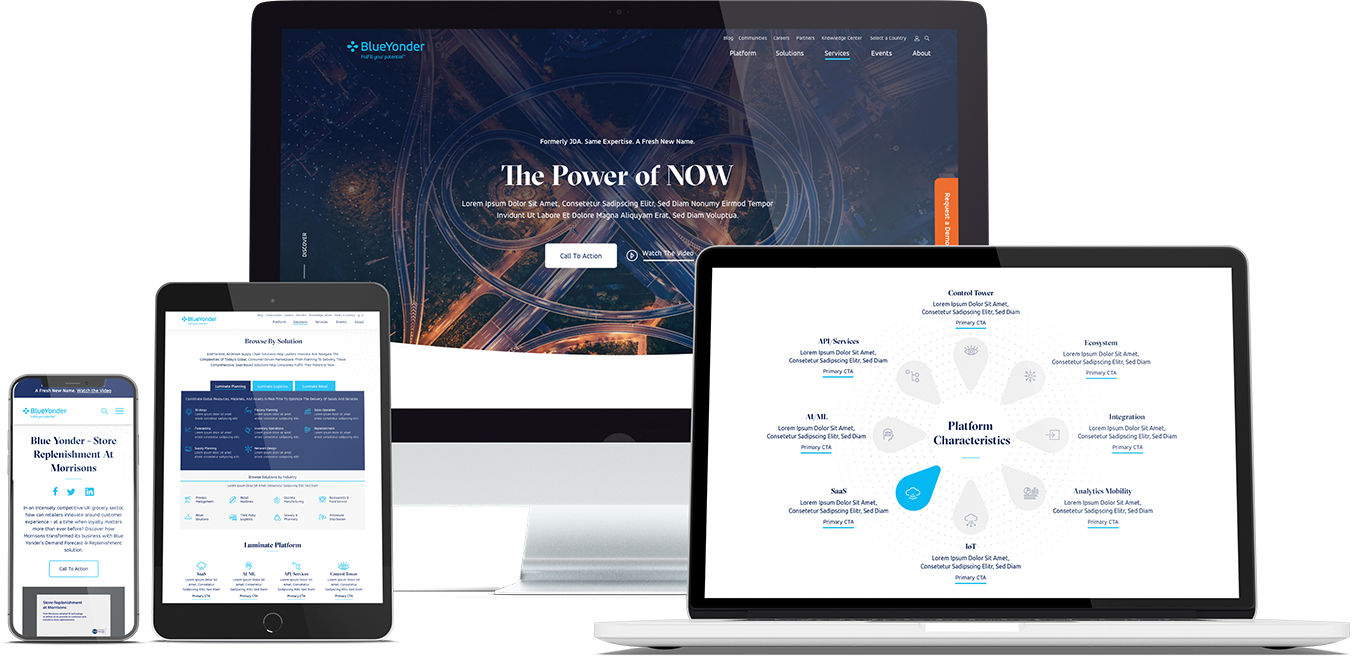
Thumb-friendly design.
With over 50% of website traffic coming from mobile devices, responsive website design has become a top priority. Menu navigation and intuitive user journey has been and always will be a top design consideration, but recently there has been a shift in attention towards mobile menu design.
How do top UX design agencies optimize for user comfort as we design for mobile? We think about adding content and important elements to the “thumb-zone”.
The “thumb-zone” includes the area at the bottom of a mobile device and on the side opposite the thumb. Test it yourself by holding your mobile device. Where does your thumb naturally fall? User studies say that about 75% of user interactions are thumb-driven, so including navigational items and important content in this zone creates a simplified and more natural user experience. In 2020, you will likely notice a lot of websites start to move away from hamburger navigation on the left side of the screen. These are often replaced by navigation bars at the bottom of the screen, aka the thumb’s natural setting.
Bluetext designed a mobile-first website for Built With Chocolate Milk, an organization that promotes the benefits of chocolate milk as a natural recovery drink. Bluetext enhanced the user experience and overall engagement through a website redesign that emphasizes the science-backed benefits of chocolate milk and showcases Built With Chocolate Milk’s impressive partnerships with world-class athletes such as Klay Thompson of the Golden State Warriors.
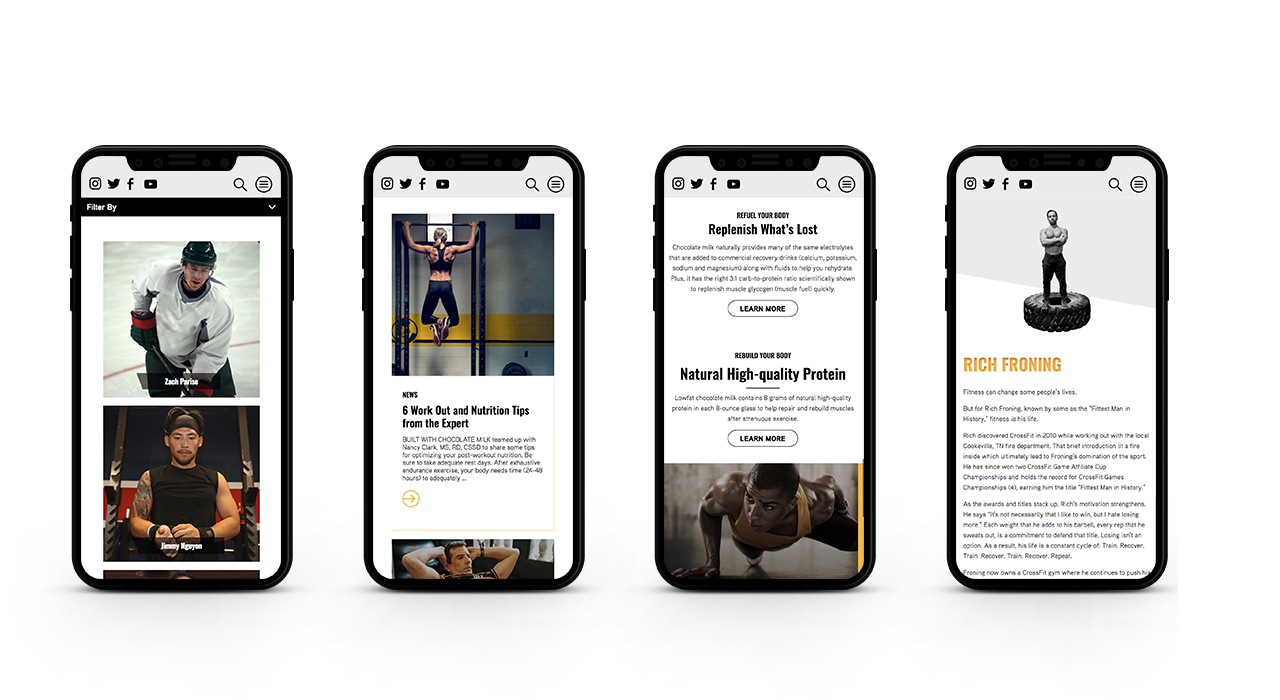
Accessibility.
With the internet being a critical part of daily life and the rise of user-centric design, it is no surprise to see accessibility on the list. When thinking through how a user gets from point A to point B, UX designers should be inclusive of those people who may have a disability and use assistive technology.
One way of keeping accessibility top of mind is to develop separate personas for users that may have low vision, deafness, or other disabilities. Persona creation is a common exercise for top digital marketing agencies when beginning a website project. But thinking beyond the expected customer personas can open insight into a more inclusive and realistic set of potential web users. Having empathy for these personas while designing will help ensure little tweaks are made that allow them to equally experience your content. For example, ensuring text is large enough for users with low vision and inclusion of space for video transcripts are all UI elements that make the website more accessible to all. With the rise of imagery- and animation-heavy sites, adding alt text to all website imagery will allow screen readers to provide context to visually impaired users. Plus, this step will kill two birds with one stone by improving your site’s SEO ranking with keyword-rich descriptions.
Added bonus: Google prioritizes websites that are more accessible to more users, so if you want to boost your SEO rankings, keep accessibility top of mind.
When the SSB Bart Group, the leading provider of accessibility solutions and software, needed a new brand to increase its market share and continue on its growth trajectory, it chose Bluetext to deliver a new name, brand, and website that would focus on its people and expertise. After a thorough discovery process, competitive review and market analysis, Bluetext proposed Level Access to simplify the brand and its promise to the industry. The new look and feel and how it is presented on the website reflects Level Access’ mission “to create a world where digital systems can be made readily accessible to users with disabilities—enabling digital technology to become a profound empowering force in their lives.”
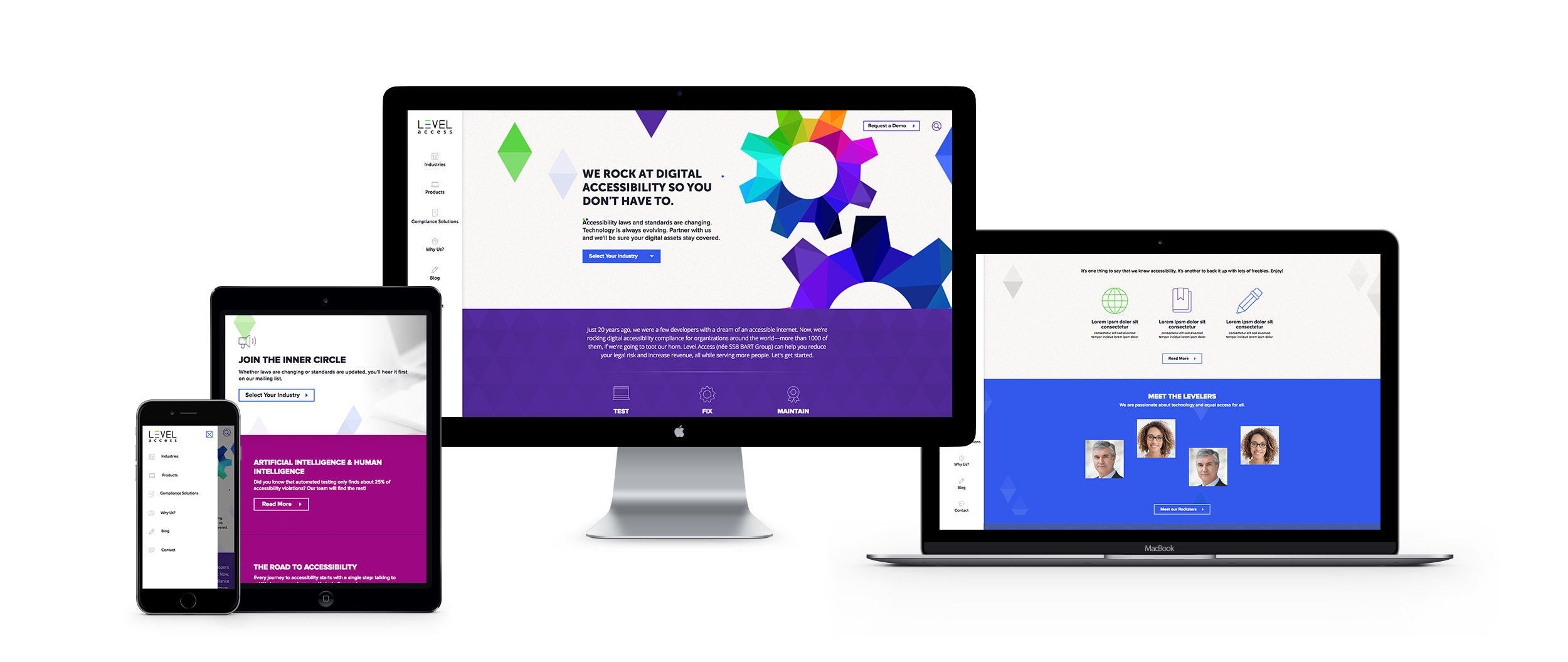
Looking for more information about the state of web design and where we’re headed? Check out some more of our case studies.
The decades-long reign of the PC is over, with mobile devices now making up more than 52% of all internet traffic. While plenty of people preach the importance of responsive website design, far fewer have articulated updated guidelines for the reality of today’s internet. Keenly aware of trends as ever, Google has continually refined its search algorithm to keep pace with increasingly mobile and untethered internet. Advertisers, marketers, and website owners alike need to be aware of what these paradigm shifts are, and how that could impact their sites’ SEO.
Cellphones’ bountiful data has empowered Google to enhance its search engine. Search results are more custom than ever before, incorporating key differentiating factors like time of day, weather, and geography. The search results for a morning bagel in Washington D.C. will look entirely different three hours later in San Francisco.
Optimizing for Local Search
More so than ever before, websites need to be local. Gone are the days of simply tacking on addresses and list of phone lines. To be competitive in 2020, websites need to address the mindset and inquiries of the region they serve, be it a street, coast, or country. A quintessential, doughy foldable New York slice is in stark contrast to a dense, deep-dish pie from Chicago. The top result for a pizza in Manhattan will not be wasting content on merely their cheese, sauce, and pepperoni, but rather what distinguishes their slice from their other New York brethren. Language, context, and local distinctions are now a mandatory part of website content strategy.

Dealing with Short Attention Spans
Major changes to search algorithms are only a handful of the changes introduced by the rise of mobile. Attention spans online are shorter than ever with the ubiquity of the internet and easily accessible information, even more so for mobile where screen size comes at a steep premium. Hero zones should be appropriately leveraged. Heroes should state the most important critical information concisely and contain a quick and simple CTA or takeaway. Organic visitors who cannot immediately find an answer to their search query after a glance and a few swipes will assuredly bounce away to a competitor.
Search and Virtual Assistants
Smartphones’ impact on websites has not just been limited to mobility and smaller screens. Virtual assistants like Amazon’s Alexa, Google Assistant, and Apple’s Siri fundamentally change how people browse the internet. For many on-the-go, the automated search functionality provided by these virtual assistants have all but replaced a typical Google search.
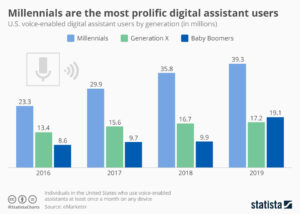
How Google and the other virtual assistants parse through webpages and present them for voice search is a complex topic, but the vital SEO fundamentals remain in place. Research demonstrates that people are unsurprisingly far more conversational in their wording versus a typed-in search. Optimized content thus needs to serve this need directly, often best served using blogs that cover such frequent, informal topics as “What is the best X” or “Y versus Z”.
Google has been increasingly leveraging its structured data for voice search results, largely due to its predictable format and parseable nature. For best results, website owners need to cross-reference website content and identify what data could be passed off to Google using structured data. Articles, menus, locations, events, and reviews are just a handful of the many structured data formats that Google accepts. Conveniently, Google now provides a simple tutorial for anybody familiar with HTML to get started on incorporating structured data and improving their site for voice search.
The shift to mobile devices has opened up new avenues for content creation and design. Location and voice were unheard of topics even a decade ago, but they are here to stay for organic search. It’s up to website owners and marketers whether they take advantage of these new strategies, or get left in the dust.
Content marketing is a consistently invaluable tool to increase conversions by educating your leads and customers. As we welcome a new year as well as a new decade, it’s important to understand the emerging content marketing trends that will dominate 2020. How should you change your digital content marketing strategy to keep pace with the ever-evolving nature of content marketing?
In this blog post, we take a look at 5 content marketing trends that will keep you ahead of the curve in 2020 and beyond.
Data-Driven Content
How are you, as a brand, determining what content is useful and relevant for your audience? That’s where data comes in. By harnessing the lessons of previously successful content marketing initiatives, companies are able to reverse engineer the data and identify KPIs that preceded the success. Once those KPI’s have been established, it is easier to create content in that same strain and capitalize on the proven success. A DC-based digital branding agency like Bluetext can assist you in determining successful KPI’s and creating the rich content your audience wants to read.
Smart Device-Centric Content
Although smart devices have been a key consideration in B2C content marketing for quite some time, this year, more focus will be placed on specific functions of smart devices such as voice search. Voice search is becoming such an integral mobile tool, 48% of consumers are using voice for “general web searches.” Companies looking to stay ahead of the curve should look to optimize their content specifically for voice search purposes. Understanding how users search via their voice will help you tailor your existing content for voice-SEO and create more effective headlines for future content initiatives. A DC digital web design agency like Bluetext can help by conducting an analysis of your audience’s voice searches and recommend changes to your existing content and future content to maximize the return on your investment.
Conversational Marketing is King
In the digital era which champions online shopping, consumers are looking to establish trust and connection through more personalized, authentic shopping experiences. Conversational marketing can aid your company in engaging with your audience in a more genuine way. By engaging in a conversation, your company gains access to more personalized data about your consumers such as their specific needs and future goals. Investing in tools such as chatbots or real human-to-human experiences can make all the difference in your competitive industry. As we progress through 2020, chatbots and other AI tools will continue to improve and positively impact lead generation.
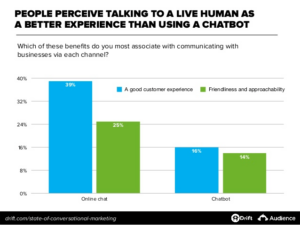
2020: The Year of the Snippet
As we know, Google dominates the search engine market share worldwide, with a resounding 92.71% of the market. When considering a user’s search intent, Google will display what they call a “snippet” at the top of the page, which provides consumers with key points within a piece of content, allowing them to receive the information they’re looking for faster. As such, it’s becoming more commonplace for consumers to enter a longtail keyword into Google, knowing that they will receive the information they’re looking for via a snippet, without clicking any page links whatsoever.
In order to win that highly coveted snippet spot, companies should look to hire an interactive web agency such as Bluetext. Bluetext’s SEO analysts can conduct an audit of your current content and pinpoint exactly where changes need to be made in order to signify to Google crawlers that your content is important. Optimizing your content for snippets will greatly enhance user experience, as users will be able to find the information they are searching for concisely and quickly. Not only will an interactive web agency audit and enhance current site content, but they will also create a content strategy and editorial calendar so your brand can continually publish content your users are searching for.
The Popularity of Podcasts
According to a recent study, 51% of the entire US population has listened to a podcast in 2019. That figure is up by 7% from the previous year. As we look ahead to 2020, podcasts will continue to dominate, as that number is expected to keep rising. Although it may seem like everyone has a podcast these days, there are still opportunities for brands to get ahead of the curve and start their own podcasts.
That being said, if you see a clear demand for audio content within your market, ensure that you create a podcast the right way. Podcasts should have clearly defined KPI’s, a regular posting schedule, and content your audience will actually care to listen to. A Virginia internet & inbound marketing agency like Bluetext can partner with your company to assess the need for a podcast in your industry and among your competitors, help you create valuable content and even develop a paid advertisement plan to spread awareness via other podcasts your audience is listening to.
2020 is already well underway and in order to achieve success, companies need to get ahead of this year’s trends with a thorough and achievable marketing strategy and plan of action. A DC digital branding agency such as Bluetext can audit your current digital content marketing strategy and suggest recommendations to help improve your current trajectory. To learn more about Bluetext and how we can help you, check out our work here.
In previous posts, we’ve discussed some of the components that top marketing firms know make a successful marketing campaign. In this post, we’ll explore why audience segmentation is so important to a campaign’s success, and how top marketing firms can drive the messaging themes and creative approach to the campaign.
One client of ours is a membership industry organization that represents information technology specialists and serves more than 140,000 professionals around the world. Its services to its members include providing services for IT professionals who need to gain the skills and qualifications required of their market.
The client partnered with us its 2018 program to reach out to its target audiences about the value it brings to this industry. Bluetext developed an email and banner ad campaign around several themes designed to communicate that value to its members, and to deliver compelling creative that would quickly get the attention of target audiences. In addition, the campaign used sophisticated programmatic and analytics-based targeting to ensure that the right target was receiving the brand message.
One of the first steps in our process to develop an effective campaign to reach the organization’s goals was to take a deep dive into its data and outreach list segmentation. We divided the campaign into four segments:
1) Students considering IT as a career
2) IT professionals in the early stages of their careers looking to move up
3) Mid-career professionals seeking to make the next career move
4) Mid-to-late career professionals seeking to stay up-to-date and relevant in their careers
For each of these four segments, we created specific messaging and creative for use in banner ads, paid social, and email targeting, with each prominently featuring the organization’s brand and logo in order to reinforce that awareness and brand recall. For example, for those starting their careers, we created themes around starting their careers, while for those in mid-career our themes focused on advancing their careers and becoming indispensable.
The results exceeded our expectations; the organization’s total brand awareness rose 13% points from its pre-campaign level. This campaign demonstrates why top marketing firms view audience segmentation as so important to a campaign’s success. Without a clear set of messages specific to each segment, target audiences would not have seen messaging and creative relevant to where they are in their careers. With those differentiated approaches, audiences responded far more positively to the campaign.
Learn How Bluetext Can Help Design and Execute Your Next Digital Campaign!
In our previous blog post, we discussed how top marketing firms take a disciplined approach to digital campaigns in order to measure, analyze, and optimize results throughout the campaign. In this post, we will talk about our process of how top marketing firms invest time and energy into the creative approach that needs to grab audiences’ attention in order to convert them into a customer.
At Bluetext, we believe that great creative approaches come from an organized process that brings in fresh minds that work across different agency disciplines. First and foremost, we go beyond the client team to engage in an agency-wide brainstorm, often getting the best ideas from colleagues who may not have ever touched the particular client. But we don’t just through them in a room and ask them to come up with great ideas. Instead, we rely on the initial team members to prepare a thorough creative brief based on the in-depth discovery that begins our process.
That brief will be based on a number of research elements, including:
- The key target audiences, including what is likely to motivate them to take action and engage with the campaign.
- The campaign’s top messaging. What do we want to get across to the target audiences that will get them to pay attention?
- Any available market research. What’s already out there to help us design the campaign, and is there additional research that needs to take place?
- The competitive landscape. What are the messages that competitors are using, and what creative are they using in their marketing?
- The client’s attitude towards the campaign. How innovative or clever is the client willing to be in this campaign? Does it need to be a conservative approach, or can something a little more edgy we acceptable?
This brief provides our team members with the guidance they need to start thinking about a creative approach that will succeed for our campaigns without reinventing the wheel or sending them down a path that we already know will not be effective.
In our next post, we will explore some recent creative examples that bring this approach altogether as part of the process that top marketing firms employ to achieve success for their clients.
Learn How Bluetext Can Help Design and Execute Your Next Digital Campaign!
Our association clients often ask us what our process is for developing digital campaigns that will deliver the best results, whether that’s awareness for their brand or attendance for their conferences and events. Top marketing firms understand that a strong, repeatable process is key to getting the right messages and creative to the right audiences at the right time. They also know that analyzing results on a continual basis is the only way to optimize performance by revising and adjusting when needed.
At Bluetext, we take a disciplined approach to every campaign, and that begins with discovery. We start by asking three questions:
- What is the goal of the campaign?
- Who are the target audiences?
- What do you want them to do?
These might sound like simple questions, but you might be surprised at the discussion that follows within the association world to get to an agreement on each of those. Top marketing firms like Bluetext know that we have to act as both a facilitator and as a honest broker who can push each stakeholder to reach that agreement. The reason is that at most membership and trade associations, there are different “clients” who have different goals for each campaign. In some cases, it might be membership renewal, while for others in the same organization it might be registration for an event that drives revenue. For others, it might be awareness of the services that the association provides.
But it’s not until that decision is made that we can move on to the next question: Who are you targeting? Again, that might sound simple, but we’ve witnessed our share of knock-down, dragged-out fights inside organizations where stakeholders have a different opinion of the audience. In some cases, part of the client team might be focused on entry-level IT professionals for their particular association, while their colleagues might believe that the true target is the mid-level professional seeking to move up in their career.
But the most difficult question seems to always come down to, What do you want them to do? The easiest response might be to do something that drives revenue, whether it is to become a member of the organization, or to renew their membership. It might also be to attend an event or purchase a service. But it might also be simple awareness of the value of the trade association and the services it brings to its members.
For each of these possible answers, there might be a multi-step process to take the action. We don’t expect, for example, a new prospect to commit to attending an annual conference just because they receive an email or see a banner ad or paid social post. It may take a sophisticated email “drip” campaign that methodically delivers different types of information that drives them down through the sales funnel before they click on a landing-page for registration. Each step of the process requires clear messaging and strong creative. And each step requires effective analytics to measure performance of the subject line (for an email) or headline (for a banner ad). We are always A/B testing subject and headlines to see which are performing the best so we can adjust accordingly.
Top marketing firms will provide detailed methodologies and analytic tools before the campaign is launched so that organizations understand exactly how the campaign will run and achieve the desired results.
Learn How Bluetext Can Help Design and Execute Your Next Digital Campaign.
In the digital age, digital marketers, companies, and thought leaders are constantly introducing new ideas making it almost impossible to keep up. Lingo overload can leave you:
- Out of touch with the latest digital marketing jargon
- Feeling left out of the marketing conversation.
- Paranoid that your boss will catch on.
That’s why Bluetext has put together a complete guide to Digital Marketing Lingo!
Bluetext, an award winning integrated digital marketing agency, has created a Digital Marketing Lingo e-Book to ensure you’re up to speed on digital marketing’s latest and greatest.
Click here to download our Digital Marketing Lingo e-Book!
In the crowded and highly-competitive government market, how do you differentiate your brand from your competitors?
While you’re thinking about how to stand out from the crowd, download a poster from our Adult Coloring Book that you can bring to life, and let Bluetext solve your bigger marketing challenges.
Click here to download our free Adult Coloring Book!